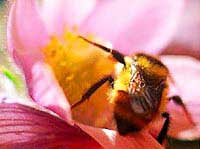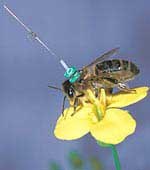What do you know about the swing dance of a bee
 The bees' strange belly dance when they arrived at the nest was to alert other bees to the location of the food they had just arrived.
The bees' strange belly dance when they arrived at the nest was to alert other bees to the location of the food they had just arrived.
The latest results of British researchers have shown that the hypothesis hypothesis introduced in the early 1960s is correct. This hypothesis has been questioned because people do not believe that bees can decode such complicated messages.
Beekeepers have long wondered about the mysterious performance of bees. When returning to the nest after completing the task of earning honey, the bee will perform a performance consisting of 8 dances by swaying the belly. Every other bee will surround and scrutinize that performance.
" At first glance, it looks confusing and unorganized. But if you look closely, you will realize a clear and regular pattern ," said study author Joe Riley at Rothamsted Research Institute, England, .
It wasn't until the 1960s, a new hypothesis was proposed to explain the purpose of the dance. The zoologist who won the Nobel Prize Karl von Frisch claimed that those bees conveyed a complicated message to show how to find food sources.
The direction of the bee facing in the dance is the direction of the food source based on the sun, while the shaking intensity of the belly dance is only its farthest, von Frisch surmises.
The hypothesis has been proven by bringing the bee to an artificial source and watching its dance describing the right location. The result is the same. But some scientists still do not believe that other bees will follow the instructions, because decoding the dance is too difficult.
 In fact, they take much longer than expected to reach that food source. This makes some researchers think that the dance is intended to perform a simpler task. Maybe they dance to attract the attention of other bees in the nest, and those bees will recognize the smell of the food source and then go find the source of the smell.
In fact, they take much longer than expected to reach that food source. This makes some researchers think that the dance is intended to perform a simpler task. Maybe they dance to attract the attention of other bees in the nest, and those bees will recognize the smell of the food source and then go find the source of the smell.
However, the latest tests prove Professor von Frisch is right. Riley and colleagues attached a radar device to the bees that observed the dance and tracked the route to find their food. They found them flying straight there. To check again, bees were taken to an area 250 meters away from the nest. They flew straight to the feeding area, proving that they did exactly the instructions in the dance.
" The results strongly supported von Frisch's hypothesis, because in this case, the bees could not follow the familiar route or smell that the dancer had left ," Riley said.
Riley's team also discovered the reason why bees take longer than expected to reach the food source. They found that although the bees flew straight to the location, they took longer to land. That's because the odorless artificial environment makes them difficult to access the flowers.
MT
- He has a dance signaling death
- Unique scientific inventions in 2005
- Men dancing also revealed gender capabilities
- The sexy tap-dance of the blue bird
- Video: The choking moment jumps from a height of 7.6 km without parachutes
- In just three years, Dubai will have the world's first 360-degree rotating building
- Robot learning to dance
- The dance of honey bees is meaningless to those who neglect
- Robots that are more than two meters high swing the rope and aerobatics
- The dance floor produces electricity
- Improve your mood by learning to dance
- Dance of healing healing of Turks
 Animal 'suffering' after hibernation
Animal 'suffering' after hibernation Why do goats climb well?
Why do goats climb well? Scientists were surprised to see chimpanzees eating turtles
Scientists were surprised to see chimpanzees eating turtles Giant catfish died deadly due to drought in Thailand
Giant catfish died deadly due to drought in Thailand How to identify bee species and how to treat stings
How to identify bee species and how to treat stings  Interesting discovery: Bees 'shake hands' with each other to play with Lego
Interesting discovery: Bees 'shake hands' with each other to play with Lego  What should you do when attacked by bees?
What should you do when attacked by bees?  Discover things you may not know about bees
Discover things you may not know about bees  How unmatched are hornets when just 30 of them are enough to 'clean up' 30,000 honey bees in just 3 hours
How unmatched are hornets when just 30 of them are enough to 'clean up' 30,000 honey bees in just 3 hours  You may not know: Queen bumblebees can live underwater for a whole week
You may not know: Queen bumblebees can live underwater for a whole week 